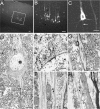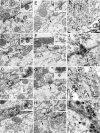Neurotropic virus tracing suggests a membranous-coating-mediated mechanism for transsynaptic communication
- PMID: 22700307
- PMCID: PMC7162419
- DOI: 10.1002/cne.23171
Neurotropic virus tracing suggests a membranous-coating-mediated mechanism for transsynaptic communication
Abstract
Swine hemagglutinating encephalomyelitis virus (HEV) has been shown to have a capability to propagate via neural circuits to the central nervous system after peripheral inoculation, resulting in acute deadly encephalomyelitis in natural host piglets as well as in experimental younger rodents. This study has systematically examined the assembly and dissemination of HEV 67N in the primary motor cortex of infected rats and provides additional evidence indicating that membranous-coating-mediated endo-/exocytosis can be used by HEV for its transsynaptic transfer. In addition, our results suggested that this transsynaptic pathway could adapted for larger granular materials, such as viruses. These findings should help in understanding the mechanisms underlying coronavirus infections as well as the intercellular exchanges occurring at the synaptic junctions.
Copyright © 2012 Wiley Periodicals, Inc.
Figures




Similar articles
-
Neuronal spread of swine hemagglutinating encephalomyelitis virus (HEV) 67N strain in 4-week-old rats.Adv Exp Med Biol. 1995;380:117-9. doi: 10.1007/978-1-4615-1899-0_19. Adv Exp Med Biol. 1995. PMID: 8830465 No abstract available.
-
Antibody-mediated virus clearance from neurons of rats infected with hemagglutinating encephalomyelitis virus.Adv Exp Med Biol. 2006;581:391-4. doi: 10.1007/978-0-387-33012-9_69. Adv Exp Med Biol. 2006. PMID: 17037565 Free PMC article. No abstract available.
-
Coronavirus infection of rat dorsal root ganglia: ultrastructural characterization of viral replication, transfer, and the early response of satellite cells.Virus Res. 2012 Feb;163(2):628-35. doi: 10.1016/j.virusres.2011.12.021. Epub 2012 Jan 11. Virus Res. 2012. PMID: 22248641 Free PMC article.
-
Viral labelling of synaptically connected neurons.Neurobiology (Bp). 1997;5(1):17-41. Neurobiology (Bp). 1997. PMID: 9302693 Review.
-
Hitchhiking on the neuronal highway: Mechanisms of transsynaptic specificity.J Chem Neuroanat. 2019 Sep;99:9-17. doi: 10.1016/j.jchemneu.2019.05.001. Epub 2019 May 7. J Chem Neuroanat. 2019. PMID: 31075318 Free PMC article. Review.
Cited by
-
An Introduction to SARS Coronavirus 2; Comparative Analysis with MERS and SARS Coronaviruses: A Brief Review.Iran J Public Health. 2020 Oct;49(Suppl 1):30-37. doi: 10.18502/ijph.v49iS1.3667. Iran J Public Health. 2020. PMID: 34268203 Free PMC article. Review.
-
Neuromechanisms of SARS-CoV-2: A Review.Front Neuroanat. 2020 Jun 16;14:37. doi: 10.3389/fnana.2020.00037. eCollection 2020. Front Neuroanat. 2020. PMID: 32612515 Free PMC article. Review.
-
Elucidating the Neuropathologic Mechanisms of SARS-CoV-2 Infection.Front Neurol. 2021 Apr 12;12:660087. doi: 10.3389/fneur.2021.660087. eCollection 2021. Front Neurol. 2021. PMID: 33912129 Free PMC article. Review.
-
Neurological Consequences of SARS-CoV-2 Infection and Concurrence of Treatment-Induced Neuropsychiatric Adverse Events in COVID-19 Patients: Navigating the Uncharted.Front Mol Biosci. 2021 Feb 18;8:627723. doi: 10.3389/fmolb.2021.627723. eCollection 2021. Front Mol Biosci. 2021. PMID: 33681293 Free PMC article. Review.
-
Considerations for future novel human-infecting coronavirus outbreaks.Surg Neurol Int. 2020 Aug 29;11:260. doi: 10.25259/SNI_191_2020. eCollection 2020. Surg Neurol Int. 2020. PMID: 33024598 Free PMC article.
References
-
- Andries K, Pensaert MB. 1980. Immunofluorescence studies on the pathogenesis of hemagglutinating encephalomyelitis virus infection in pigs after oronasal inoculation. Am J Vet Res 41: 1372–1378. - PubMed
-
- Bai WZ, Hirano N, Taniguchi T, Tohyama K, Hashikawa T. 2006. Spatial and time‐dependent transneuronal propagation of swine coronavirus (hemagglutinating encephalomyelitis virus, HEV) in the rat central nervous system after its hind footpad inoculation. Neurosci Res 55: S106–S106.
-
- Charlton KM, Casey GA. 1979. Experimental rabies in skunks: immunofluorescence light and electron microscopic studies. Lab Invest 41: 36–44. - PubMed
-
- Charlton BT, Gray EG. 1966. Comparative electron microscopy of synapses in the vertebrate spinal cord. J Cell Sci 1: 67–80. - PubMed
Publication types
MeSH terms
Substances
LinkOut - more resources
Full Text Sources

